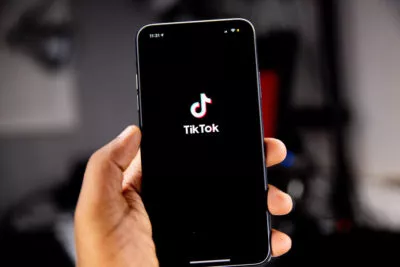
- Originally Published on May 30, 2023
What to Do If You Are Being Harassed on TikTok
In today’s digital age, social media platforms are both a blessing and a curse. They connect millions of people from around the world—but they can also be a hotbed for harassment, bullying, and “viral” content that damages your reputation without warning.
If you are being harassed on TikTok, it is important to act quickly. We recommend taking the following steps:
- Familiarize yourself with TikTok’s Community Guidelines,
- Preserve evidence of the harassment,
- Avoid responding to the harasser,
- Set your TikTok account and online profiles to private,
- Seek support from your friends and family,
- Report the harassment to TikTok for Terms of Service violations,
- Report the harassment to law enforcement (in emergency situations), and
- Work with an experienced attorney to pursue legal action, if necessary.
At Minc Law, we know how to stop harassment on TikTok and other social media platforms. We can help you navigate reporting procedures, remove and flag content, and identify anonymous users. And crucially, we can stop harassment without drawing further attention to the matter—which is essential on a platform like TikTok, where content can easily go viral.
In this article, we explore the various types of harassment commonly seen on TikTok. Then, we explain what to do if you are the victim of TikTok harassment, up to and including taking legal action against the perpetrator(s).
Types of Online Harassment on TikTok
TikTok is the sixth most popular social media platform in the world, behind only Facebook, YouTube, Instagram, and the messaging apps WhatsApp and WeChat. Its U.S. audience alone is estimated to be 80 million monthly active users, and the average user spends an astonishing 95 minutes daily on the app.
Due to TikTok’s ubiquity and prominence, it is a breeding ground for countless attacks and forms of online harassment.
What Are the Common Types of Harassment on TikTok?
There are several ways malicious users can attack and harass others on TikTok. In this section, we list seven of the most frequent, along with the impacts of the harassment on your health and personal life.
Online Harassment & Cyberbullying
Online harassment is a general term for behavior that involves repeatedly threatening or alarming a victim, placing them in reasonable fear of physical injury. The harassment may be related to the victim’s race, national origin, ancestry, gender, religion, age, disability, or sexual orientation.
Often used interchangeably with ‘online harassment’, cyberbullying is online bullying that can devastate your well-being and mental health. On TikTok, for example, a harasser may begin leaving threatening or humiliating comments under every video you post. Or they may repeatedly stitch your videos and use insulting, shaming, and derogatory language about you.
Defamation
A TikTok user commits defamation against you when they share false statements about you that harm your reputation.
If the defamation is written (such as in comments or captions), it is considered libel. Spoken defamation—such as in original videos, stitches, duets, or live streams—would be classified as slander.
Please see our comprehensive guide explaining how to combat TikTok defamation for further reading.
Trolling
Trolling on TikTok involves leaving comments or messages with the intention of causing emotional distress or a hostile environment. Trolls do not want to hold good-faith conversations; their goal is to stir up outrage.
They may use derogatory language, make personal attacks, or threaten physical harm. Trolls often target their victims based on race, gender, or sexual orientation.
Online Impersonation
When a TikTok user commits online impersonation, they either hack into your account or create a new, false account pretending to be you. They then use their platform to damage your reputation, harass or stalk you, or communicate with your friends and family.
The perpetrator’s goal is usually to intimidate, threaten, or defraud their victim.
Hate Speech
Hate speech promotes discrimination and violence against protected groups. Comments or videos attacking and dehumanizing you based on your race, ethnicity, gender, religion, or other marginalized status qualify as hate speech.
Not only is hate speech offensive and inflammatory, but it can also incite real-world violence toward people and groups. Thus, it should always be taken seriously.
Doxxing
Doxxing (or doxing) is sharing someone’s personally identifiable information—like their name, contact information, or employer—without their consent. A doxxer aims to give other internet users the information they need to track down and threaten or harm the victim.
If a TikTok user wants to have a content creator fired from their job over a controversial video, for example, they may share the individual’s employer and encourage their followers to contact the company to report them.
Revenge Porn
Revenge porn is the act of sharing explicit photos or videos of an individual without their permission. On TikTok, this may look like an original video, stitch, or duet containing private and sexually explicit images of you.
TikTok’s Terms of Service ban revenge porn and encourage users to report any content that contains sexually explicit material. Additionally, posting revenge porn is illegal in many jurisdictions, and victims may be able to take legal action against the perpetrators.
Impacts of Being Harassed on TikTok
Harassment on TikTok can uproot your life in countless ways. Not only does it make your experience on social media difficult; it can affect your mental and physical health—as well as your personal and professional life.
Damage to Your Mental, Emotional, & Physical Health
Studies show that 34% of young adults and adolescents have experienced cyberbullying, which leads to low self-esteem and increased anxiety and depression.
Increased exposure to negative comments and personal attacks can even result in physical symptoms like headaches, digestive issues, and chronic pain. In extreme cases, the stress of being harassed on TikTok might contribute to symptoms of PTSD.
In some extreme situations, harassment victims may be tempted to resort to self-harm. Please understand that nothing is ever worth taking this kind of extreme action. You matter, and your mental health matters. If you are considering self-harm, please call the Suicide Prevention Helpline at 988 at any time of day or night.
Damage to Your Personal & Professional Life
Beyond your mental and physical health, the consequences of TikTok harassment can affect your personal and professional well-being. Being harassed online can strain your relationships with family and friends—especially if harassers are accusing you of misconduct or poor ethics.
Professionally, online harassment and negative accusations can lead to job loss and make it difficult to find new work or professional opportunities. If your income depends on being in the public eye—like if you are a social media influencer or own a consumer-facing business—TikTok harassment can tarnish your reputation and make it hard to find clients, partners, or sponsorships.
Why Harassment on TikTok Poses a Threat to Individuals
Engagement drives the TikTok algorithm. The “For You” page suggests videos the algorithm thinks each viewer will find interesting; it does not matter whether they are following the creator or not.
Given the nature of the platform, every TikTok video has the potential to go viral. A video defaming or harassing you could be seen by hundreds of thousands (or even millions) of users extremely quickly and without warning.
What to Do If You Are Being Harassed on TikTok
Being harassed on TikTok can be extremely traumatic and overwhelming. You may not know where to turn or how to end the harassment.
Below, we explore several key steps that will increase your chances of ending TikTok cyberbullying and reclaiming your life.
Familiarize Yourself With TikTok’s Community Guidelines
TikTok has several policies and features designed for preventing harassment on its platform. According to TikTok’s Community Guidelines, any behavior that is intended to bully, intimidate, or harass others should be reported immediately.
For instance, TikTok’s Community Guidelines prohibit content that contains the following:
- Insults against an individual based on attributes like appearance, intellect, hygiene, or personality;
- Threats or wishes of death or harm;
- Coordinated harassment against a user; or
- Cyberstalking, trolling, and other wilful harm and intimidation.
These guidelines are not limited to original content. Videos made using TikTok’s interactive features (like duet and stitch) can also be reported and removed for harassment and other content violations.
The TikTok team of moderators reviews and removes rule-violating content. We provide more tips for reporting content below. You may also want to visit TikTok’s Safety Center for more tips for staying safe on the platform.
Preserve Evidence of the Harassment
Depending on the type and severity of the harassment, you may need to take legal action against the perpetrator(s) to get them to stop. It is important to gather as much proof of the TikTok harassment as you can. Save not only the original video but any stitches or duets contributing to the harassment.
You can save TikTok videos by tapping the arrow icon, then tapping “Save video.”
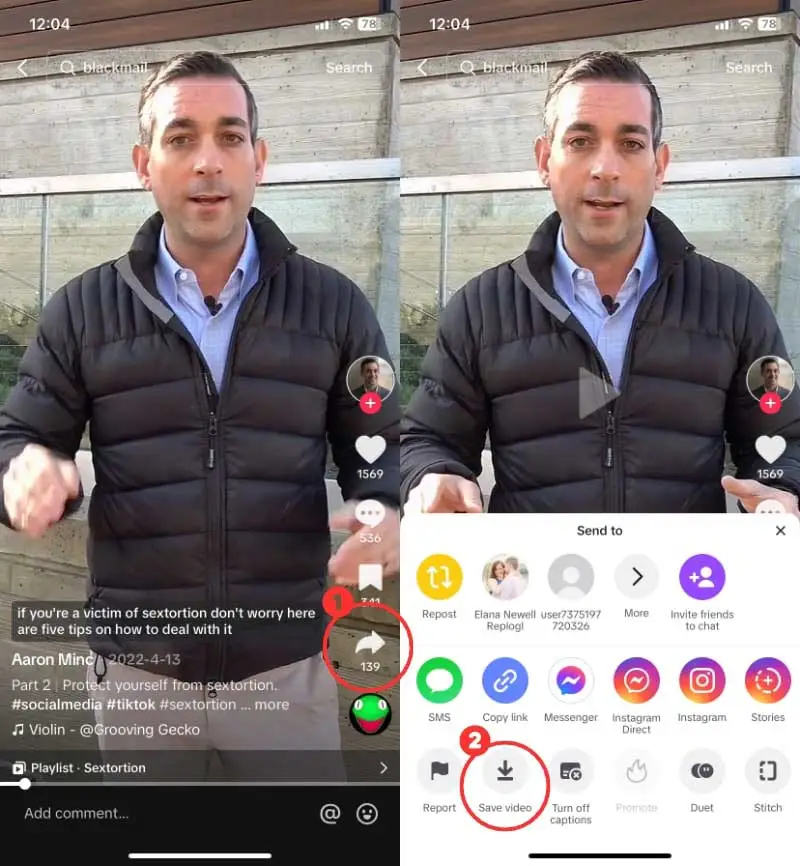
If the video(s) in question have limited sharing settings, you can save the video using your phone’s built-in screen recorder or third-party software.
You may also want to preserve other proof of how the harassment is impacting your life. Save screenshots of comments on TikTok and other platforms relating to the harassment. You should also save messages from family and friends about the cyberbullying and how it has affected you.
Avoid Responding to the Harasser
While it is understandable to want to respond to public insults and derogatory statements on TikTok, avoid this urge. In most cases, responding publicly will only escalate the situation.
The harasser’s goal is to upset and provoke you—so responding to them will likely encourage them to keep contacting you. And starting a public argument with the harasser can draw more unwanted attention to the situation (otherwise known as the Streisand Effect).
Set Your TikTok Account & Online Profiles to Private
At Minc Law, we believe everyone should maximize their online privacy settings. Limiting how much strangers know about you helps protect you from harassment, fraud, and invasion of privacy concerns.
If you are being harassed on TikTok or any other online platform, it becomes even more important to protect your online privacy.
To change your TikTok privacy settings, follow these steps:
1. Tap Profile in the bottom right of your screen.

2. Tap the 3-line icon in the top right of your profile, then tap Settings and Privacy.
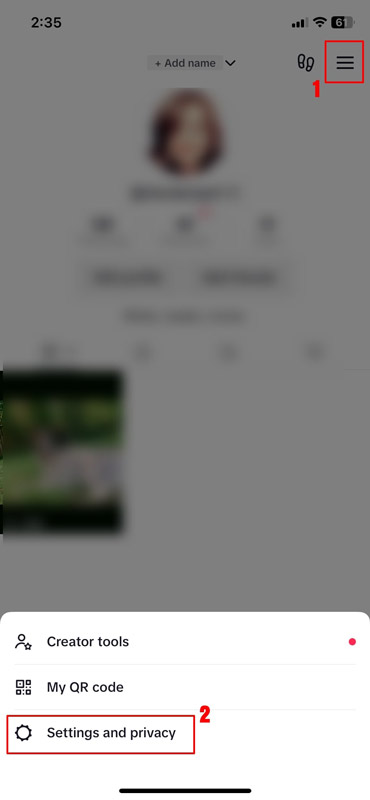
3. Tap Privacy.
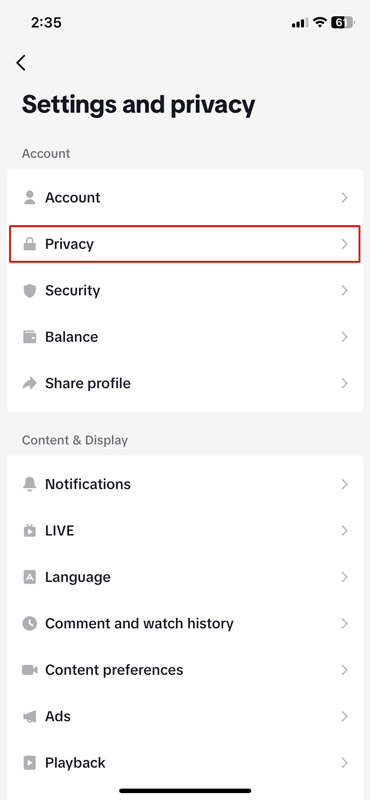
4. Turn the Private Account toggle on.
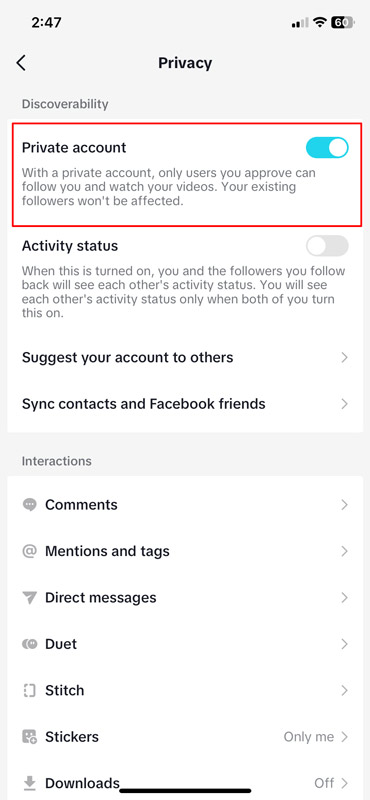
Seek Support from Friends & Family
Being the subject of TikTok harassment can be isolating and humiliating. Remember: you do not have to go through this experience alone.
Reach out to your trusted friends and family for support. Communicate honestly and openly with those closest to you about how your experience is affecting you and what kind of support you need from them. Try spending time with loved ones and unplugging from social media to protect your mental well-being.
You can also reach out to the following resources and helplines for judgment-free support from trained professionals:
- Get Safe Online—Information and tips for protecting your family’s and business’s online privacy;
- Cyber Civil Rights Initiative—Resource center dealing with online abuses that threaten civil rights and civil liberties (such as revenge porn);
- Cybersmile Help Center—Information and non-emergency support for victims of online abuse;
- eSafety Commissioner—Resources and reporting for Australian residents experiencing cyber abuse; and
- The Cyber Helpline—Tips and support for victims of cybercrime in the United Kingdom.
Report the Harassment to TikTok For Terms of Service Violations
Harassing and defamatory content is a violation of TikTok’s Community Guidelines. While reporting the content in question does not guarantee it will be removed, TikTok’s moderation team may use their discretion to remove it or suspend the user if they agree with you. Reporting harassment also helps TikTok’s moderation team identify patterns of abusive behavior and develop strategies to address it more effectively in the future.
To report harassment on TikTok, navigate to the harasser’s profile. Long-tap on their username in the video, message, or comment containing the harassment.
From their profile page, tap the arrow at the top right of the screen.
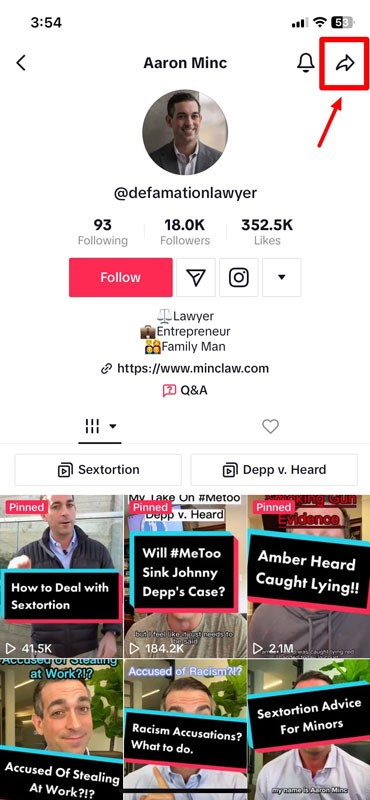
From the menu that appears, select Report.
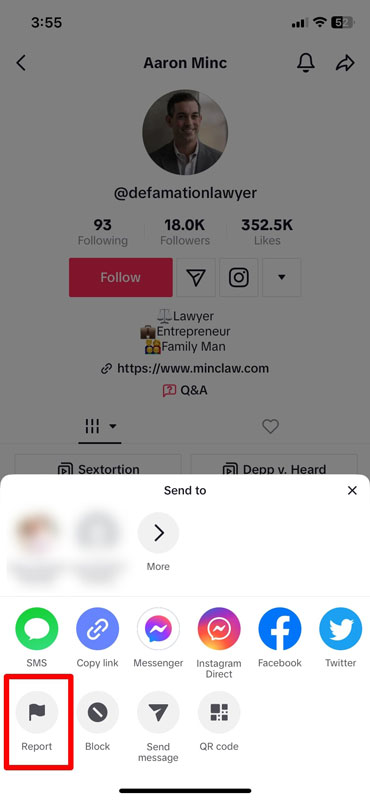
You can choose to Report account or Report content.

From there, follow the instructions that best match your situation. For instance, you can report the account for “Posting inappropriate content,” or follow the instructions to report a specific video.
Remember to preserve any evidence of harassment—such as videos or screenshots—in case the moderation team asks for further proof or if further legal action is necessary.
Report to Law Enforcement (For Emergency or Unlawful Harassment Situations)
If the harasser made threats of bodily harm or more sinister intent, you may want to make a report to law enforcement, as well. Your local police can submit a law enforcement request to TikTok to obtain the perpetrator’s information and save evidence of harassing content for up to 90 days.
Pursue Legal Action (if Necessary)
If the harassment continues after you have reported the poster and maximized your privacy, it may be necessary to take legal action. An experienced internet attorney can help you file a lawsuit against the perpetrator and seek a restraining order to prevent them from contacting you further.
We address several common legal options for TikTok harassment victims in the next section.
Legal Options For Dealing With Harassment on TikTok
To help you determine the best course of action for your specific situation, consult with a qualified attorney with experience handling harassment cases.
Experienced internet attorneys can help preserve evidence of the harassment, flag and report content, explore potential valid legal claims and file lawsuits, obtain court orders to remove content, and work with law enforcement.
In this section, we explore five possible legal options for responding to and ending harassment on TikTok.
Consider Pursuing a Civil Suit
Although harassment is not a standalone civil claim in many states, other claims may be available to you based on the type of harassment you have been experiencing, such as:
In a civil lawsuit, you could seek damages for the harm caused by the harassment, such as emotional distress. You can also seek an injunction to prevent the harasser from contacting or persecuting you.
A civil lawsuit can be a lengthy and complex process, so should always be a last resort—and it is important to have the support of a knowledgeable and experienced attorney.
Pursuing Criminal Charges Under State Harassment Laws
You may be able to press criminal charges for harassment on TikTok if the harassment involves criminal activity, such as stalking, threats of violence, or the distribution of sexually explicit images without your consent.
If you ever feel that your safety is being threatened, start by approaching law enforcement, not filing a civil suit.
Depending on the specific circumstances of the case, criminal charges may be filed against the harasser, which could result in fines, probation, or even imprisonment. The definition and prosecution process for harassment varies by state.
For example, cyber harassment is defined under Section 653.2 of the California Penal Code as electronically posted information about an individual that:
- Was made without the victim’s consent,
- Is likely to incite unlawful action,
- Contains personally identifying information,
- Contains a harassing message about the individual, and/or
- Is made with the intent to instill a reasonable fear in the victim for their or their family’s safety.
In other words, say a TikTok creator displays a photo of the victim and explains details of where they work. Then, the video’s caption reads, “Let’s get this guy fired… or just show up and punch him in the face.” This video may qualify as cyber harassment in California.
Cyber harassment penalties in California include a fine of up to $1,000, up to one year in county jail, or both. To pursue criminal charges under California law, start by contacting your local law enforcement and filing a report.
You may also need to obtain a restraining order against the individual for behavior such as stalking, violence, or threats. Consult with an attorney in your area who specializes in obtaining restraining orders to discuss your options further.
For more details on how to report harassment and the legal remedies available to you, see our list of state-by-state harassment guides.
Send a Cease & Desist Letter
Sending a cease and desist letter is often a quicker and more cost-effective strategy to stop harassment on TikTok than filing a civil lawsuit. These letters are formal warnings to stop the harmful behavior or face legal consequences. They typically outline the details of the harassment and the harm it has caused, then demand that the harasser immediately end their activities. In some cases, the letter may also demand an apology or retraction of the harmful or defamatory statements.
A cease and desist letter can be more cost-effective than taking the case to court. It signals that the victim is prepared to take legal action if the harassment continues. The harasser may be persuaded and take the posts down themselves—and even apologize for their behavior.
While a cease and desist letter is simpler than a civil lawsuit, it must be curated carefully and with an experienced hand. Forms and templates are usually not effective in online harassment situations. It is always advisable to have an experienced attorney draft a cease and desist letter or retraction demand letter.
Send a DMCA Takedown Notice
The Digital Millennium Copyright Act of 1998 (DMCA) makes it illegal to post copyrighted material online without your consent. If the harasser is posting images or videos that you took, you may be able to have them removed with a DMCA takedown notice.
While you cannot use a DMCA takedown to simply compel the removal of any information you do not like, it can potentially be used to remove content that you own.
The DMCA notice must include specific information about the copyrighted material and be filed with TikTok’s designated DMCA agent. If the notice is found to be valid, TikTok must remove the infringing content or face potential legal action.
Utilize a Digital Risk Protection Service to Monitor for Future Threats on TikTok
If you are the target of online harassers, you may want to retain a digital risk protection service that can help monitor and bolster your online reputation. Digital Risk Protection (DRP) services use a combination of online tools and methods to pinpoint, monitor, and prevent potential online threats.
If You Want to Put an End to TikTok Harassment, We Can Help
Being harassed, bullied, or defamed on TikTok can be overwhelming and you may feel like it will never end. However, there are options.
At Minc Law, we have extensive experience putting an end to online harassment and other internet attacks on popular social media platforms, holding perpetrators accountable for their actions, and monitoring the internet for subsequent digital threats and attacks.
★★★★★
“Trust me, you don’t want to get into these messes, but I feel a lot more at ease having spoken with the kind folks here at Minc Law. It really won’t hurt to call and assess your options.”
JMS
Jan 26, 2022
Take your first step to putting an end to the internet abuse by calling us at (216) 373-7706, speaking with a Chat representative, or filling out our online contact form.
This page has been peer-reviewed, fact-checked, and edited by qualified attorneys to ensure substantive accuracy and coverage.


